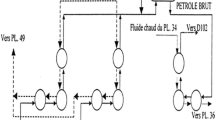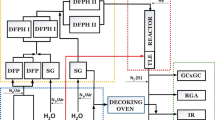Abstract
Fouling phenomena, generally related to heavy crude oils and bituminous petroleum fractions, nevertheless affects significantly the preheat train (PHT) of the light Algerian crude oil. In this study, a two dimensional model was developed using the computational fluid dynamic (CFD) method in order to investigate fouling behavior in the PHT of Algiers refinery. A fouling model was proposed specifically for the studied crude oil. The model includes a pseudo detailed chemical kinetic mechanism and it considers the deposition of inorganic matters. The proposed model was validated using the experimental results from literature. The simulation results show good agreements with the experimental data. The deposition mechanism of the two fouling routes was studied by analyzing the effect of flow velocity on the thermo-hydraulic conditions of near wall regions. The results indicate that the chemical reaction fouling is controlled by kinetic reaction process and the deposition of inorganic species is dominated by mass diffusion. The distribution of the initial fouling rate was evaluated along the entire heat exchangers network. The simulation results show that the inorganic process was predominant at the first heat exchanger and the chemical reaction fouling reaches its maximum at the PHT outlet.

















Similar content being viewed by others
Availability of data and material
The data that support the findings of this study are available from the corresponding author upon reasonable request.
Abbreviations
- C p :
-
specific heat capacity, J kg−1 K−1
- C b :
-
Bulk iron oxides concentration, kg m−3
- D j :
-
mass diffusion coefficient of species j, m2 s −1
- e d :
-
deposit thickness, m
- E a :
-
activation energy, J kg−1 mol−1
- G k :
-
production rate of k, J kg−1 S −1
- G ω :
-
production rate of ω, J kg−1 S −1
- J i :
-
diffusion flux of species i, kg m −2s −1
- K:
-
clean overall heat transfer coefficient, W m −2 K−1
- k :
-
production rate of turbulent kinetic energy, J kg−1 S −1
- K a :
-
attachment coefficient, m s−1
- K a 0 :
-
Arrhenius factor, m s−1
- K d :
-
deposition coefficient, m s−1
- K t :
-
transportation coefficient, m s−1
- m d :
-
deposit mass per unit area, kg m−2
- M w,j :
-
molecular weight of species j, g mol−1
- P:
-
pressure, Pa
- Q d :
-
mass deposition rate, kg m −2 s−1
- r j :
-
intrinsic reaction rate of species j
- R:
-
universal gas constant, J kmol−1 K−1
- R f :
-
fouling resistance, m2 K W−1
- \( {\boldsymbol{R}}_{\boldsymbol{i}}^{"} \) :
-
production rate of species i due to surface reaction, kg m −2 s−1
- S :
-
heat exchange area at the axial distance x, m 2
- T S :
-
surface temperature, K
- \( \overline{\boldsymbol{u}} \) :
-
velocity vector, m s−1
- Y j :
-
mass fraction of species j
- Y i,wall :
-
mass fraction of species i at the wall
- Y k :
-
destruction rate of k
- Y ω :
-
destruction rate of ω
- ASTM:
-
American Society for Testing and Materials
- PHT:
-
Preheat Train
- QUICK:
-
Quadratic Upstream Interpolation for Convective Kinematics
- SIMPLE:
-
Semi Implicit Method for Pressure Link. Equations
- SSB:
-
Syncrude Sweet Blend
- SST:
-
Shear Stress Transport
- γ :
-
kinematic viscosity, Pa.s
- Ε:
-
dissipation rate of turbulent kinetic energy in k- ε eq. J kg−1 S −1
- λ d :
-
thermal conductivity of deposit species, W m −1 K −1
- μ :
-
dynamic molecular viscosity, kg m−1 s−1
- μ t :
-
turbulent dynamic viscosity, kg m−1 s−1
- ρ :
-
density, kg m −3
- ρ d :
-
density of deposit species, kg m −3
- σ :
-
turbulent Prandtl number
- ω :
-
dissipation rate of turbulent kinetic energy in k-ω eq. J kg−1 S −1
- E :
-
Reaction number
- I :
-
Referring to deposit species
- J :
-
Referring to bulk species
- S :
-
Surface
- W :
-
Wall
References
Coletti F, Hewitt GF (2015) crude oil fouling: deposit characterization, measurements, and modeling. Gulf Professional Publishing (Elsevier), Boston
Watkinson AP (2007) Deposition from crude oils in heat exchanger. Heat Transfer Eng 28:177–184
Rammerstorfer E, Karner T, Siebenhofer M (2019) The kinetics and mechanisms of fouling in crude oil heat transfer. Heat Transfer Eng. https://doi.org/10.1080/01457632.2018.1564202
Bayat M, Aminian J, Bazmi M, Shahhosseini S, Sharifi K (2012) CFD modelling of fouling in crude oil pre-heaters. Energy Convers Manag 64:344–350
Fontoura DVR, Matos EM, Nunhez JR (2013) A three-dimensional two-phase flow model with phase change inside a tube of petrochemical pre-heaters. Fuel 110:196–203
Yang J, Maria G, Serratos J, Parole DSF, Muller EA, Matar OK (2015) Crude oil fouling: fluid dynamics, Reactions and Phase Change. Procedia IUTAM 15:2210–838. https://doi.org/10.1016/j.piutam.2015.04.026
Emani S, Yusoh NA, Ramasamy M, Shaari KZK (2017) Effect of operating conditions on crude oil fouling through CFD simulations. Int J Heat Technol 35:1034–1044. https://doi.org/10.18280/ijht.350440
Emani S, Ramasamy MK, Shaari KZK (2018) Discrete phase-CFD simulations of Asphaltenes particles deposition from crude oil in Shell and tube heat exchangers. Appl Therm Eng. https://doi.org/10.1016/j.applthermaleng.2018.12.008
Cucumo MA, Galloro A, Greco N, Mele M, Nicoletti F, Perrone D (2019) Thermal Fluid Dynamics Analysis of Crude Oil Fouling in a Heat Exchanger with Internal Mechanical Inserts Tecnica Italiana-Italian J Eng Sci 63: 151–157
Peyghambarzadeh SM, Vatani A, Jamialahmadi M (2012) Experimental Study of Micro–Particle Fouling Under Forced Convective Heat Transfer Brazilian. J Chem Eng 29:713–724
Wang Y, Yuan Z, Liang Y, Xie Y, Chen X, Li X (2015) A review of experimental measurement and prediction models of crude oil fouling rate in crude refinery preheat trains Asia-Pac. J Chem Eng 10:607–625. https://doi.org/10.1002/apj.1895
Harche R, Mouheb A, Absi R (2016) The fouling in the tubular heat exchanger of Algiers refinery. Heat Mass Transf 947:1–10. https://doi.org/10.1007/s00231-015-1609-0
Harche R, Absi R, Mouheb A (2014) Study of the fouling deposit in the heat exchangers of Algiers refinery. Int J Ind Chem 5:1–8. https://doi.org/10.1007/s40090-014-0016-6
Kuprowicz N.J, Zabarnick S, West Z.J, Jamie S.E (2007) Use of measured species class concentrations with chemical kinetic modeling for the prediction of autoxidation and deposition of jet fuels. Energy Fuel 21: 530–544
West ZJ, Adams RK, Zabarnick S (2011) Homogeneous catalysis of liquid-phase hydroperoxide decomposition in hydrocarbons. Energy Fuel 25:897–904
Li Y, Watkinson P, Fahiminia F, James M (2007) Formation of gum and deposits in an oxygenated naphtha stream volume RP5: proceedings of 7th international conference on heat exchanger fouling and cleaning - challenges and opportunities. Tomar, Portugal
Turner CW (2013) Fouling of nuclear steam generators: fundamental studies, operating experience and remedial measures using chemical additives. AECL Nuclear Rev 2:61–88. https://doi.org/10.12943/ANR.2013.00007
Turner, C. W., & Godin, M. (1994). Mechanisms of magnetite deposition in pressurized boiling and non-boiling water (No. AECL--11046). Atomic Energy of Canada Ltd., Chalk River, Ontario
ANSYS Fluent Theory Guide (2013), ANSYS, Inc., 275 Technology Drive Canonsburg,. PA 15317, November 2013
Wilcox DC (2006) Turbulence modeling for CFD, 3rd edn. D.C.W. Industries, Inc., LA
Kakaç S, Hongtan Liu H, Pramuanjaroenkij A (2012) Heat exchangers: selection, rating, and thermal design, 3rd edition. CRC Press/Taylor & Francis Group, Boca Raton
Riazi MR (2005) Characterization and properties of petroleum fractions. Journal of ASTM International: Manual Series vol. 50
Sawhney GS (2010) Heat and mass transfer. I. K. International Pvt Ltd., New Delhi
Deshannavar UB, Rafeen MS, Ramasamy M, Subbarao D (2010) Crude oil fouling: a review. J Appl Sci 10(24):3167–3174
Watkinson AP, Navaneetha-Sundaram B, Posarac D (2000) Fouling of a sweet crude under inert and oxygenated conditions. Energy Fuel 14:64–69
Acknowledgements
The authors are indebted to the LBMPT laboratory (Laboratoire Mécanique Physique et Modélisation Mathématique Université de Médéa, Faculté de Technologie) for use Ansys program.
Funding
No funding was received for conducting this study.
Author information
Authors and Affiliations
Corresponding author
Ethics declarations
Conflict of interest
The authors report no conflicts of interest. The authors alone are responsible for the content and writing of this article.
Additional information
Publisher’s note
Springer Nature remains neutral with regard to jurisdictional claims in published maps and institutional affiliations.
Rights and permissions
About this article
Cite this article
Kerraoui, I., Mahdi, Y. & Mouheb, A. CFD investigation of fouling mechanisms in the crude oil preheat network. Heat Mass Transfer 57, 1411–1424 (2021). https://doi.org/10.1007/s00231-021-03040-x
Received:
Accepted:
Published:
Issue Date:
DOI: https://doi.org/10.1007/s00231-021-03040-x




